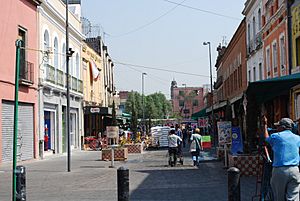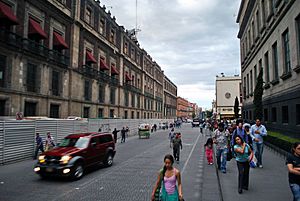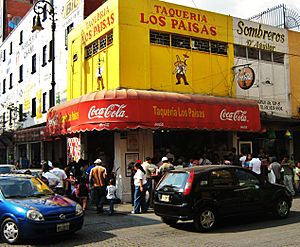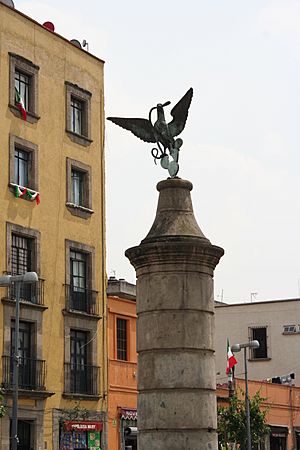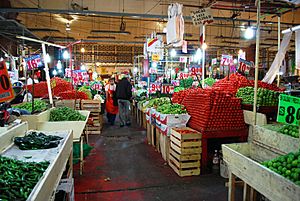La Merced (neighborhood) facts for kids
La Merced is a special neighborhood in Mexico City. It's known for its long history and busy markets, rather than being an official city area. This part of the city is very old, started over 700 years ago by the Mexica people when they founded their great city, Tenochtitlan.
For centuries, La Merced has been a hub for trade. First, it was a major port where boats brought goods from Lake Texcoco to Tenochtitlan. Later, as the lake was drained, canals continued to bring products. In the late 1800s, the famous La Merced market was built here. It replaced a huge monastery that was mostly destroyed. The market was created to bring all the city's food sales into one central place. The first market building was from 1890, and the current, much larger one opened in 1957. It's now one of the biggest traditional Mexican markets in Mexico City. Even today, La Merced market is very important, and there have been efforts to make the area even better.
Contents
Exploring La Merced: A Unique Neighborhood
La Merced is a "barrio," which means it's an unofficial part of Mexico City. You can find it in the southeast corner of the city's historic center. Its exact boundaries can be a bit flexible, but generally, it's bordered by Corregidora, Zavala, and Candelaria streets to the north, Fray Servando Teresa de Mier to the south, Congreso de la Unión to the east, and José María Pino Suárez to the west.
This area covers about 106 city blocks, which is around 121 hectares. That's about 13.5% of Mexico City's historic center! It's even part of a World Heritage Site, with about 40% of its buildings being historic.
Officially, La Merced is split between two of Mexico City's main areas: Cuauhtémoc and Venustiano Carranza. It's also divided into smaller official neighborhoods called "colonias," like Merced Balbuena and Colonia Centro.
The neighborhood's identity comes from its history and the way people live and work there. A huge monastery, called La Merced monastery, used to cover most of this area. The neighborhood is divided into three main parts:
- The "Antigua" (Old) Section: This is the largest part, with 97 blocks. It used to be where the La Merced monastery and the first market were located. People have lived here for a long time, though some have moved out, just like in other parts of the historic center. Many businesses here have changed from small shops to warehouses, except for the very western part. This western area is mostly for shopping and has many street vendors.
- The San Pablo Section: This area was once a special shrine called Teopan. It's bordered by Fray Servando Teresa de Mier to the south, San Pablo to the north, Circunvalación to the east, and Pino Suárez to the west. It has two smaller parts: one around the San Lucas plaza and another with two churches called San Pablo el Viejo and San Pablo el Joven.
- The Current La Merced Market Area: This section is dominated by the modern La Merced market, often called "las naves" (the naves). It's part of the Venustiano Carranza borough. This area includes the market itself, a residential area with the Candelaria de los Patos apartment complex, and another residential area along Congreso de la Unión.
Life and Culture in La Merced
La Merced is known for its strong community spirit, shaped by its history and economy. It has always been a place for buying and selling, especially traditional Mexican foods. Because many businesses are family-run and new people have moved in over the years, the neighborhood has a unique social structure with many close-knit groups.
In the 20th century, the area offered many jobs in commerce, attracting people from all over Mexico and other countries. It became home to various Mexican indigenous groups like the Triquis, Mazahuas, Otomis, Mazatecos, Nahuas, Chinantecos, and Purépechas.
People also came from other countries, including Lebanese, Jewish, Spanish, Greek, Italian, Turkish, French, Syrian, Irish, Hungarian, Polish, Russian, African, German, Croatian, Bohemian, and Armenian people from Europe. There were also immigrants from Asia, like Chinese, Japanese, Filipinos, and Indians, as well as people from Africa and the Middle East.
One famous spot linked to this immigration is Café Bagdad, a popular place for the Lebanese community to enjoy Middle Eastern coffee. It's known for its old cash register, delicious coffee, and pastries. La Merced remains a multicultural place, though Catholic festivals are still very important.
Even though it's part of Mexico City's historic center and a World Heritage Site, La Merced has faced challenges. It doesn't have as many cultural attractions as other parts of the historic center. This is partly because of changes like people moving away and big roads being built, which divided the area. This history has made residents cautious about government projects. Many buildings used to be homes, storage, and shops all at once, with shops on the ground floor and homes above. Now, many upper floors are empty, even though the city needs more housing.
Mysteries and Legends of La Merced
Besides its rich history, La Merced is full of fascinating legends and ghost stories.
- The Ghost of Esperanza: One tale tells of Esperanza Goyeneche de Ruiz Garica, whose ghost is said to appear in the narrow alleys.
- The Priest and the Thief: Another story from the old Merced church says a priest once caught a thief. To warn others, the priest cut off the thief's hand and displayed it in the church. You can even see a symbol of a hand at the entrance of a house facing the Plaza Alonso Garcia Bravo, which refers to this legend.
- The Giant Rat: In the 1980s, a rumor spread about a huge, fifty-kilo rat! People blamed it for the disappearance of cats and dogs. Even though no proof was ever found, many still believe the story. They say the rat grew so big from eating all the garbage from the La Merced market.
Historic Places and the Famous Market
Most buildings in La Merced are used for business, not just for their historical value. However, there are many important historic sites. In 1980, seventeen sites were declared part of the World Heritage Site. The INAH (Mexico's National Institute of Anthropology and History) has declared 39 sites historic, and 33 more are listed in other catalogs.
Some of the most important landmarks include:
- The cloister of the La Merced monastery.
- The parish of La Soledad.
- The church and former convent of Jesús María.
- The former monastery of San Gerónimo.
- The Candelaria chapel.
- The parishes of Santo Tomás de la Palma, San Pablo el Viejo, and San Pablo en Nuevo.
- The San Luca chapel.
- The monastery hospital of San Camilo.
- The San José de Gracia church.
- The Hospital San Lázaro.
- The Palace of the Counts of Calimaya.
- The Casa Talavera.
Other historic spots are the Casa de las Gallas, the Casa de Calpixques, the former Garita de San Lázaro, and the Casa de Diezmo. Sadly, 39 of these buildings are at high risk of being lost.
The most famous landmark in La Merced isn't an old building, but the huge market itself, La Merced. It's located in the heart of the neighborhood, between Anillo de Circunvalación and Morazán streets. This market is one of the largest of its kind in Latin America! The main building is 400 meters long and has over 3,000 stalls. It even has its own Metro station inside.
Years ago, it was not only the main wholesale market for Mexico City but also for the entire country. The "Nave Mayor" (main hall) sells fresh produce, while the "Nave Menor" sells meat, fish, dairy, and packaged foods. A section called the "desnivel" (not-level) has many food stalls. There's also an area for handicrafts, tools, and toys, plus annexes for flowers (fresh and artificial) and candy.
While still very important, in its busiest times, the market supported hundreds of human carriers called "mecalapers," watchmen, baggers, and warehouse workers. It also supported trades like carpentry, tailoring, and glassworking, and businesses like restaurants, lodging, and bars specializing in pulque.
The neighborhood's name, La Merced, comes from a monastery built in the late 16th century. Its full name was Nuestra Señora de la Merced de la Redención de los Cautivos (Monastery of Our Lady of Grace of the Redemption of Captives). It was the only major Mercedarian establishment in New Spain. Today, all that's left of this huge complex is a small cloister near the Plaza Alonso García Bravo, famous for its detailed carvings.
Another important colonial religious building was the Jesús María convent, founded in the 16th century for wealthy Spanish women. It was even home to the illegitimate daughter of Philip II of Spain. Only the main courtyard of the convent and its church remain. The convent building used to be a furniture store and a cinema, but now it's empty and being restored by INAH.
Talavera Street, near the La Merced Market, is a notable area. Today, it's a pedestrian-only street with an altar dedicated to the Santo Niño de Atocha. This altar celebrates the area's tradition of selling items for Child Jesus figures in Mexico, especially clothes for ceremonies like Candlemas. Now, the street also sells clothing for people. At the corner of Talavera and El Salvador, there's a large old mansion from the 18th century. It has a red tezontle stone facade with simple decorations. This is the Casa Talavera, which is now a cultural center. It's named Talavera because it was the first place in Mexico to produce Talavera pottery. It once belonged to the Marquis of San Miguel de Aguayo.
Next to the Casa Talavera is a square called Plaza Aguilita (little eagle) or Plaza Juan José Baz. In its center, there's a fountain with a figure of an eagle on a nopal cactus with a snake in its mouth. This is important because, according to tradition, this is where the Mexica people saw this sign, telling them to build their city here.
The Plaza Alonso Garcia Bravo has a permanent outdoor market called a tianguis. The stalls sometimes block the view of the fountain and a monument to the Spaniard who planned Mexico City after the conquest. On the north side of the plaza, there are several interesting buildings. One has a beautifully decorated niche with an image of Apostle James the Great. At the top of the niche, there's an image of a hand, which reminds people of the legend of the thief. Another building from 1870-1906 has three levels in a Neo-classical style. The building next to it stands out with three large arches on its front. The names of the architects and stone workers are carved on their walls. One other building is unique for its series of winged fish inside niches.
The Parish of Santo Tomás La Palma has a beautiful Baroque entrance made of sandstone, featuring a carving of Christ on the cross. It has a wide, single-level bell tower in the center. Inside, the ceilings have paintings, and the main altar shows Saint Thomas touching Christ's wound. The dome has angel decorations and an image of Juan Diego with the Virgin of Guadalupe. The archway leading to the sacristy is also very notable.
The Casa del Diezmo, also called Alhóndiga, dates back to the 16th century. Only the front of the building remains, with a small bridge in front that reminds us of the canal that once flowed there. Its original purpose was to collect a ten-percent tax for the church from all business activities in the city.
Manzanares Street is home to the Manzanares Church, which is thought to be the smallest church in Mexico City. Off one of its alleys, there's a large 16th-century home. It's special because it's the only one from that time still standing that was owned by an indigenous person.
A Journey Through Time: La Merced's History
Ancient Beginnings
La Merced is one of the oldest parts of Mexico City, settled by the Mexica people over 700 years ago. It was known as Tempan or Teopan. Legend says that this is where the Mexica saw the sign from the god Huitzilopochtli to stop their travels: an eagle on a cactus with a snake in its beak. The first temple to this god was built on what was then a small island in Lake Texcoco. As the city of Tenochtitlan grew, this area became the southeast corner of the city. Even when the temple to Huitzilopochtli was moved, the area remained important, with a shrine to Ehécatl, the Casa de Pajaros, and a place that made pulque (a traditional drink) for the royal palace.
Colonial Era
After the Spanish conquered the Aztec Empire, Tenochtitlan was rebuilt, but the new city plan didn't change this area much. It was already full of canals and chinampas (artificial islands for farming). At first, the only changes were wider plazas and bridges for horses and carriages. Political changes began early, with the territory divided into three parts: Parcialidad de San Pablo, Cuartel, and Colonia Centro.
Even though the neighborhood's name, La Merced, is now linked to the modern market, it actually comes from the La Merced monastery. However, the area has been connected to trade since the early colonial period. Even as efforts began to drain Lake Texcoco, canals were vital for bringing goods from other parts of the Valley of Mexico into Mexico City. Most goods arrived in this neighborhood by canal until the early 20th century. During the colonial period, the main grain market was here, as was the building where the Church collected its tithe (a ten-percent tax), called the Alhóngida Casa del Diezmo. Two of the largest and richest monasteries of the time, Jesús María and La Merced, were also here, along with grand mansions like the Marquis de Aguayo's, now known as the Casa Talavera.
The Parcialidad de San Pablo-Teopan remained an important part of the city, with government buildings, churches, and other key structures. Many of these still exist, in whole or in part, including the former monastery of La Merced, the convent of Jesús María, and churches like Santo Tómas La Palma and San Pablo el Viego.
While La Merced was a main entry point for goods in the colonial period, the main markets were initially around the main square, or Zocalo. These were often noisy and messy open-air markets called tianguis. Over time, the city tried to organize and modernize wholesale and retail sales. In 1791, the Mercado de Volador market was built near the Zocalo, where the Supreme Court now stands.
After Independence
By the late 1800s, the Mercado de Volador became too crowded. In the 1860s, new laws took over the monastery lands, and much of it was destroyed. The merchants from Volador were moved to this area. This move transformed the Merced neighborhood into the commercial hub it is today.
The most significant change was taking over the lands of the La Merced monastery (which covered most of the current neighborhood) to build shops and homes. In the 1860s, this huge monastery complex was almost completely torn down as part of efforts to modernize Mexico City's historic center. In 1890, the first La Merced Market was built to bring all food sales into one place and modernize the informal markets that already existed along the canals. This change also encouraged the development of services like electricity, running water, telegraph, and new ways to travel, such as trains, trolleys, and cars.
20th Century to Today
At the start of the 20th century, the neighborhood was politically divided when the Federal District was reorganized. The western part became part of the Cuauhtémoc borough, and the eastern part joined the Venustiano Carranza borough. The Mexican Revolution caused a decline in trade, but it slowly recovered after the fighting ended, returning to previous levels by the 1950s. During this decade, La Merced became Mexico City's most important wholesale food market. This led to new businesses and services, like hotels, taxis, bus terminals, and public restrooms.
The growth of trade in the first half of the 20th century attracted many people to La Merced, both from within Mexico and from other countries, especially between the 1930s and 1950s. Mexican migrants came from rural areas and included various indigenous groups. Foreign immigrants were mostly Arab, Lebanese, and Jewish groups, as well as Armenians, Greeks, Spanish, French, Italians, and Hungarians, among others. Almost all of them became involved in commerce, working in shops or owning businesses. Immigrants helped diversify the area's trade, expanding into household items, handicrafts, fabric, paper goods, and clothing.
In the 1950s, Mexico City mayor Ernesto P. Uruchurtu started new modernization projects. Old apartment buildings were replaced by large new ones, especially in the La Candelaria de los Patos and La Soledad areas. Major roads like Anillo de Circunvalación, Pino Suárez, Fray Servando Teresa de Mier, and San Pablo were built and widened. However, the most famous project was replacing the 19th-century La Merced market with the current building. This new market was designed by architect Enrique del Moral and opened in 1957, built next to the Anillo de Circunvalación.
From the 1960s to the early 1980s, Mexico City's historic center continued to grow rapidly and became very crowded. In the 1980s, the Mexico City government decided to encourage development in other parts of the city. New apartment buildings were built in areas like Iztapalapa, and the main inter-city bus station was closed, with its services moved to four new stations. However, the most important change was the construction of the Central de Abasto in Iztapalapa, which took over La Merced's role as the city's main wholesale food market.
Even though the first Metro line was built through the area, the changes in trade and affordable housing disrupted La Merced's community. Many families moved out, following jobs and other resources in Iztapalapa. The neighborhood's condition worsened further due to the damage from the 1985 Mexico City earthquake.
In the 1980s, La Merced, along with the rest of the historic center, was declared a World Heritage Site. This allowed for efforts to preserve some of its historic buildings. However, a lack of clear plans and money made it hard to fully carry out these preservation efforts. The 1985 earthquake affected parts of the area, including historic buildings. Most reconstruction efforts had to focus on building new homes to replace those destroyed.
Since the 1980s, the population of La Merced has continued to decrease. Some areas have become almost entirely commercial, with new businesses like paper goods stores opening after 1985. These businesses often took over former living spaces, like the second and third floors of buildings. This change also led to real estate speculation. Most of the remaining residents now live on the west side of the traditional area, starting from the Aguilita plaza, which acts as a barrier to commercial growth into the western side.
Starting in the 2000s, there have been efforts to improve parts of the neighborhood, making it more appealing to tourists and visitors. Several streets, such as Republic de El Salvador, Mesones, Roldán, Santo Tomas, and Corregiadora, have been turned into the "Alhóndiga-Talavera pedestrian corridor." This corridor has better lighting and signs. A Metrobus line has been established through the area, and the Turibus (a tourist bus) also passes through part of it. Between 2009 and 2012, 100 million pesos were invested in this pedestrian area. This money also helped restore the fronts of several historic buildings, improve commercial spaces like Roldán, and redesign the Plaza Alonso García Bravo.
See also
 In Spanish: La Merced (Ciudad de México) para niños
In Spanish: La Merced (Ciudad de México) para niños
- La Merced Market


